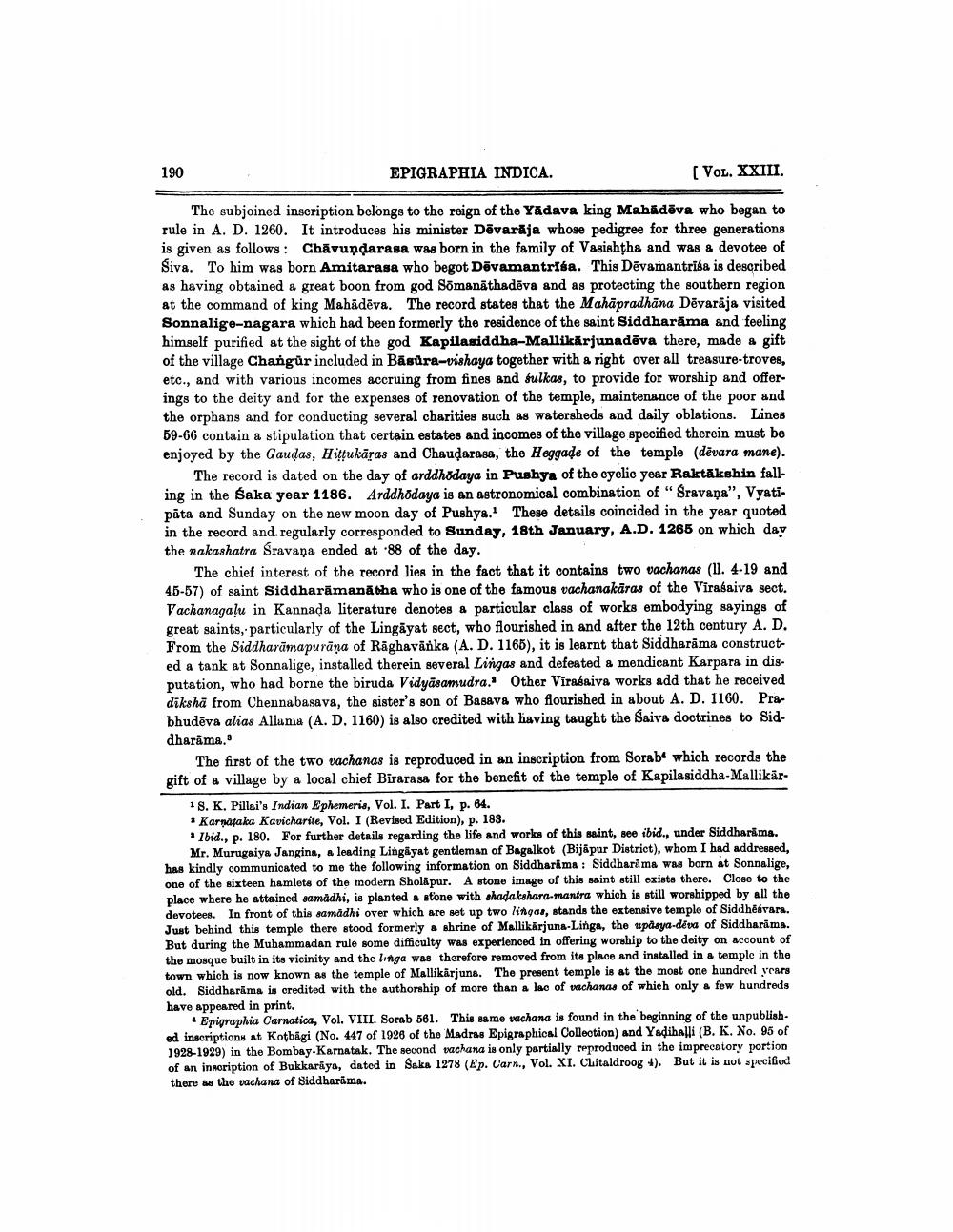________________
190
EPIGRAPHIA INDICA.
[VOL. XXIII.
The subjoined inscription belongs to the reign of the Yadava king Mahādēva who began to rule in A. D. 1260. It introduces his minister Devaraja whose pedigree for three generations is given as follows: Chavupḍarasa was born in the family of Vasishtha and was a devotee of Siva. To him was born Amitarasa who begot Devamantrisa. This Devamantrisa is described as having obtained a great boon from god Sōmanathadēva and as protecting the southern region at the command of king Mahādēva. The record states that the Mahapradhana Dēvarāja visited Sonnalige-nagara which had been formerly the residence of the saint Siddharama and feeling himself purified at the sight of the god Kapilasiddha-Mallikarjunadēva there, made a gift of the village Changür included in Basüra-vishaya together with a right over all treasure-troves, etc., and with various incomes accruing from fines and sulkas, to provide for worship and offerings to the deity and for the expenses of renovation of the temple, maintenance of the poor and the orphans and for conducting several charities such as watersheds and daily oblations. Lines 59-66 contain a stipulation that certain estates and incomes of the village specified therein must be enjoyed by the Gaudas, Hittukaras and Chaudarasa, the Heggade of the temple (devara mane).
The record is dated on the day of arddhodaya in Pushya of the cyclic year Raktakshin falling in the Saka year 1186. Arddhodaya is an astronomical combination of "Sravana", Vyatipata and Sunday on the new moon day of Pushya. These details coincided in the year quoted in the record and. regularly corresponded to Sunday, 18th January, A.D. 1265 on which day the nakashatra Sravana ended at 88 of the day.
The chief interest of the record lies in the fact that it contains two vachanas (11. 4-19 and 45-57) of saint Siddharamanatha who is one of the famous vachanakaras of the Virasaiva sect. Vachanagalu in Kannada literature denotes a particular class of works embodying sayings of great saints, particularly of the Lingayat sect, who flourished in and after the 12th century A. D. From the Siddharamapurana of Raghavanka (A. D. 1165), it is learnt that Siddharama constructed a tank at Sonnalige, installed therein several Lingas and defeated a mendicant Karpara in disputation, who had borne the biruda Vidyasamudra. Other Virasaiva works add that he received diksha from Chennabasava, the sister's son of Basava who flourished in about A. D. 1160. Prabhudeva alias Allama (A. D. 1160) is also credited with having taught the Saiva doctrines to Siddharama.3
The first of the two vachanas is reproduced in an inscription from Sorab which records the gift of a village by a local chief Birarasa for the benefit of the temple of Kapilasiddha-Mallikar
1 S. K. Pillai's Indian Ephemeris, Vol. I. Part I, p. 64.
* Karnataka Kavicharite, Vol. I (Revised Edition), p. 183.
Ibid., p. 180. For further details regarding the life and works of this saint, see ibid., under Siddharäma. Mr. Murugaiya Jangina, a leading Lingayat gentleman of Bagalkot (Bijapur District), whom I had addressed, has kindly communicated to me the following information on Siddharama: Siddharama was born at Sonnalige, one of the sixteen hamlets of the modern Sholapur. A stone image of this saint still exists there. Close to the place where he attained samadhi, is planted a stone with shadakshara-mantra which is still worshipped by all the devotees. In front of this samadhi over which are set up two lingas, stands the extensive temple of Siddhēévara. Just behind this temple there stood formerly a shrine of Mallikarjuna-Linga, the upäsya-deva of Siddharams. But during the Muhammadan rule some difficulty was experienced in offering worship to the deity on account of the mosque built in its vicinity and the linga was therefore removed from its place and installed in a temple in the town which is now known as the temple of Mallikarjuna. The present temple is at the most one hundred years old. Siddharama is credited with the authorship of more than a lac of vachanas of which only a few hundreds have appeared in print.
Epigraphia Carnatica, Vol. VIII. Sorab 561. This same vachana is found in the beginning of the unpublished inscriptions at Kotbägi (No. 447 of 1926 of the Madras Epigraphical Collection) and Yadihalli (B. K. No. 95 of 1928-1929) in the Bombay-Karnatak. The second vachana is only partially reproduced in the imprecatory portion of an inscription of Bukkaraya, dated in Saka 1278 (Ep. Carn., Vol. XI. Chitaldroog 4). But it is not specified there as the vachana of Siddharäma.




